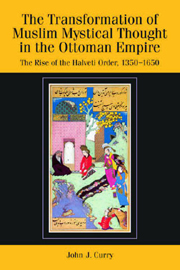 The Transformation of Muslim Mystical Thought in the Ottoman Empire
The Transformation of Muslim Mystical Thought in the Ottoman Empire Book contents
- Frontmatter
- Contents
- List of Maps and Figures
- Abbreviations for Frequently Cited Works in the Text
- Acknowledgments
- Note on Transliteration
- Map 1
- Map 2
- INTRODUCTION: ON THE STUDY OF OTTOMAN MYSTICAL TRADITIONS
- PART I THE RISE AND SPREAD OF THE HALVETİ ORDER FROM ITS ORIGINS THROUGH THE ELEVENTH/SEVENTEENTH CENTURY
- INTRODUCTION
- 1 EARLY SUFISM AND THE ORIGINS OF THE HALVETİ PATH, C. 900–1400
- 2 THE GREAT EXPANSION: FROM REGIONAL ORGANIZATION TO FAR-FLUNG NETWORK, C. 1400–1600
- PART II THE EVOLUTION OF A HALVETİ SUB-BRANCH: THE LIFE AND CAREER OF ŞAcBÂN-I VELİ AND HIS FOLLOWERS IN THE KASTAMONU REGION
- PART III DEFENDING THE CULT OF SAINTS IN ELEVENTH/SEVENTEENTH-CENTURY KASTAMONU: TRANSFORMING THE ŞAcBÂNİYE ORDER UNDER cÖMER EL-FUɔÂDÎ
- CONCLUSION: WHAT CAN THE ŞAcBÂNİYE TEACH US ABOUT TRANSITIONS IN THE EARLY MODERN PERIOD OF WORLD HISTORY?
- Appendix I
- Appendix II
- Works Cited and Further Reading
- Index of Persons
- Index of Places
- Index of Subjects
2 - THE GREAT EXPANSION: FROM REGIONAL ORGANIZATION TO FAR-FLUNG NETWORK, C. 1400–1600
from PART I - THE RISE AND SPREAD OF THE HALVETİ ORDER FROM ITS ORIGINS THROUGH THE ELEVENTH/SEVENTEENTH CENTURY
Published online by Cambridge University Press: 12 September 2012
- Frontmatter
- Contents
- List of Maps and Figures
- Abbreviations for Frequently Cited Works in the Text
- Acknowledgments
- Note on Transliteration
- Map 1
- Map 2
- INTRODUCTION: ON THE STUDY OF OTTOMAN MYSTICAL TRADITIONS
- PART I THE RISE AND SPREAD OF THE HALVETİ ORDER FROM ITS ORIGINS THROUGH THE ELEVENTH/SEVENTEENTH CENTURY
- INTRODUCTION
- 1 EARLY SUFISM AND THE ORIGINS OF THE HALVETİ PATH, C. 900–1400
- 2 THE GREAT EXPANSION: FROM REGIONAL ORGANIZATION TO FAR-FLUNG NETWORK, C. 1400–1600
- PART II THE EVOLUTION OF A HALVETİ SUB-BRANCH: THE LIFE AND CAREER OF ŞAcBÂN-I VELİ AND HIS FOLLOWERS IN THE KASTAMONU REGION
- PART III DEFENDING THE CULT OF SAINTS IN ELEVENTH/SEVENTEENTH-CENTURY KASTAMONU: TRANSFORMING THE ŞAcBÂNİYE ORDER UNDER cÖMER EL-FUɔÂDÎ
- CONCLUSION: WHAT CAN THE ŞAcBÂNİYE TEACH US ABOUT TRANSITIONS IN THE EARLY MODERN PERIOD OF WORLD HISTORY?
- Appendix I
- Appendix II
- Works Cited and Further Reading
- Index of Persons
- Index of Places
- Index of Subjects
Summary
By the middle decades of the ninth/fifteenth century, a clearer picture of the activities of Halveti leaders begins to emerge, as the chronological distance between them and their Ottoman biographers narrows. As a result, historians can be more certain when they discuss linkages between prominent Halveti figures and other personalities and events appearing in their societies. During this period, dating from the ninth/fifteenth to the eleventh/seventeenth centuries, the range and activities of Halveti leaders expanded dramatically. This chapter provides a broad outline of how the order spread and its sub-branches multiplied and took a position of widespread political, religious, and social power and influence in the Islamic world as a whole. This process of growth and expansion also became intimately intertwined with the expansion of the Ottoman Empire's power and influence.
In the centuries that followed the disruptions wreaked by the Timurid invasions, several factors encouraged the growth of the Halveti order's membership. The first of these was increased interest among Anatolian Turkish Muslims, who wished to gain a better knowledge of the traditions of their faith. Initially, not all Anatolians embarked on this quest willingly. We know that Temür forcibly relocated many captured intellectuals and artisans eastward to Iran and Central Asia, who later returned bearing an increased knowledge of the traditions and scholarship of the eastern Islamic world as a by-product of their exile there.
- Type
- Chapter
- Information
- The Transformation of Muslim Mystical Thought in the Ottoman EmpireThe Rise of the Halveti Order, 1350–1650, pp. 50 - 86Publisher: Edinburgh University PressPrint publication year: 2010
